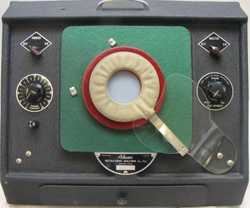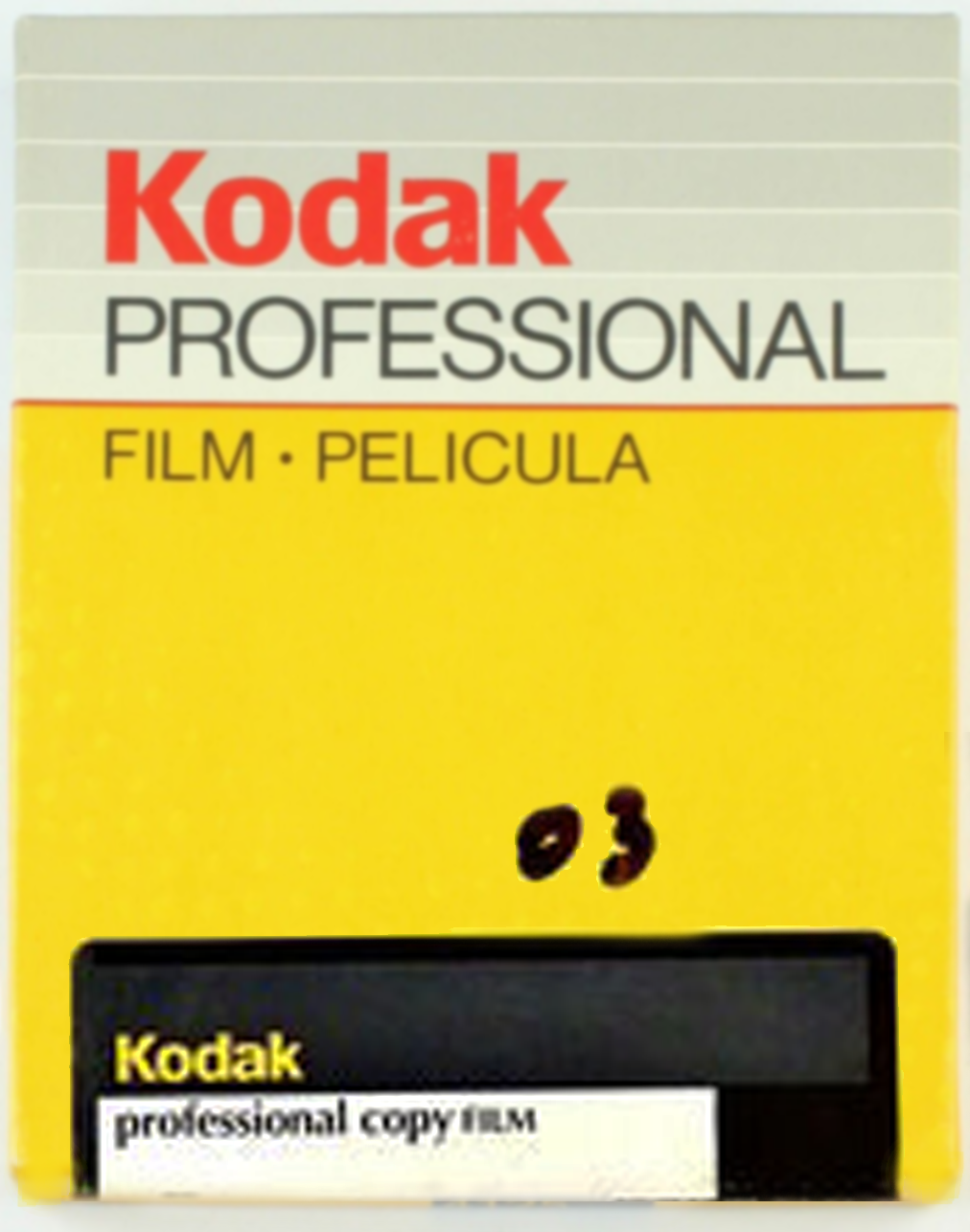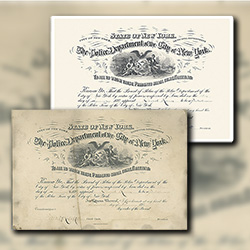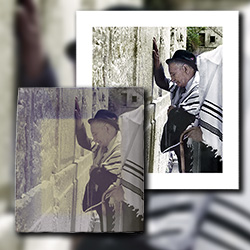RESTORATION, PRESERVATION & ARCHIVING
MENU
RESTORATION FAQ
Here are some of our most common questions about photo restoration process and services, such as:
- How long does it take to restore a photograph?
- How much does it cost to restore a photograph?
- Can I send you a scan of a photograph to be restored?
- Can you fix a photograph that is covered with some sort of silver residue?
- Can you restore the original photograph instead of making a copy?
- I have a document signed by one of the Presidents of the United States but the signature has faded. Can you make the signature visible again?
- Can you enlarge a small photograph?
- Is it possible to change a background on an old photograph?
- How do I protect old photographs and documents from fading?
- How long do the digital prints last?
- Can I make additional prints from digital files myself?
- How safe is it to mail my photograph or documents?
- Do you keep digital copies of photographs, and for how long?
- Do you accept credit cards?
- Do you offer film processing and scanning services?
HOW LONG DOES IT TAKE TO RESTORE A PHOTOGRAPH?
Typically, restoring a photograph takes between 5 to 10 business days. However, if the photo is significantly damaged or if Sebastian is busy with a large project, it might take a little longer. Keep in mind that during peak seasons, the increased volume can also affect turnaround times.
Clients are encouraged to submit their photographs for restoration well ahead of holidays like Veterans Day, Mother's Day, Father's Day, Thanksgiving, and Christmas.
While there are no options for 'rush' jobs, we can expedite quality work for an additional fee to help meet your deadlines.
HOW MUCH DOES IT COST TO RESTORE A PHOTOGRAPH?
Restoration is truly an art form, and every project brings its own unique challenges. We can provide an estimate only after carefully examining the original photograph and discussing your specific needs, including how you want the original item treated. For digital restorations, we'll also consider factors like the quality of the final print, its size, and options for display, mounting, and framing.
To obtain an estimate, we invite you to schedule an appointment where we can assess your photographs and answer any questions you might have about the restoration process.
CAN I SEND YOU A SCAN OF A PHOTOGRAPH TO BE RESTORED?
If you are unable to bring a photograph to the studio or send it to be restored you can e-mail a scan or send a thumb drive with high resolution scan file. Please have a photograph scanned at minimum resolution of 300dpi (600dpi or more if photograph is to be enlarged) at full color setting, even if photograph is black and white.
However, please remember that producing a high quality photo scan is the first and one of the most important steps in photo restoration. Unlike many discount photo restoration services that use low quality scanners in hope that later whatever imperfections of the scan, low resolution or color changes can be fixes in Photoshop, Sebastian Wintermute utilizes high quality equipment to ensure capture of even the smallest details or the most minute color variations of the original that are needed for high quality photo restoration and art replication.
 To see the difference in quality of images produced with professional high resolution photo scanners comparing to images produced by a common scanner you can examine the two scans of the same photograph.
To see the difference in quality of images produced with professional high resolution photo scanners comparing to images produced by a common scanner you can examine the two scans of the same photograph.
Both scans were made at 600dpi resolution.
The scan on the left was made with a common all-in-one printer/copier/scanner.
The scan on the right was made with a calibrated photo scanner set specifically for high quality output.
The photo scanner result is much sharper, has better color balance and saturation. Magnification shows even the smallest details while the other scanner blurred details.
CAN YOU FIX A PHOTOGRAPH THAT IS COVERED WITH SOME SORT OF SILVER RESIDUE?
Many of old silver gelatin prints show signs of “silver migration” or “silver mirror”. If a photograph was not properly processed, over time, some of the silver begins to surface creating a shiny layer.
Unfortunately little that can be done to remove this layer. Some photo restorers use a light coating of Vaseline to reduce the appearance of silver migration, however this may irreversibly damage the print. Sebastian Wintermute has successfully restored “silver migration” damage to historically significant photographs by expert retouching of a high quality scan of the original.
CAN YOU RESTORE THE ORIGINAL PHOTOGRAPH INSTEAD OF MAKING A COPY?
Traditional photo retouching services are offered on a case-by-case basis. If an original photograph is damaged only slightly, it may still be possible to reduce the appearance of scratch marks and other imperfections by careful application of retouching spot tones.
 A common misconception about photo restoration is the idea that skilled restorers in the past had an extraordinary ability to fix and revive original photographs, no matter their condition. This is not entirely true. While a proficient restorer can tackle minor issues like scratches, small marks, or tears, any major damage requires making a copy of the original image.
A common misconception about photo restoration is the idea that skilled restorers in the past had an extraordinary ability to fix and revive original photographs, no matter their condition. This is not entirely true. While a proficient restorer can tackle minor issues like scratches, small marks, or tears, any major damage requires making a copy of the original image.
 Typically, the process involved capturing the original image on a special copy film, such as Kodak Professional Copy Film 4125, designed specifically for retouching. After creating a copy, the photo restorer would carefully retouch the negative, removing all visible damage and flaws with specialized tools and pencils. Once the retouching was complete, the negative would be printed onto photo paper, resulting in a restored version of the damaged photograph.
Typically, the process involved capturing the original image on a special copy film, such as Kodak Professional Copy Film 4125, designed specifically for retouching. After creating a copy, the photo restorer would carefully retouch the negative, removing all visible damage and flaws with specialized tools and pencils. Once the retouching was complete, the negative would be printed onto photo paper, resulting in a restored version of the damaged photograph.
In modern practices, instead of creating a negative from the original photograph, a digital file is produced by scanning the image with a high-quality scanner. After retouching the digital file, the restored image is printed on specially designed paper that provides better quality and durability than traditional photo papers.
I HAVE A DOCUMENT SIGNED BY ONE OF THE PRESIDENTS OF THE UNITED STATES, BUT THE SIGNATURE HAS FADED.
CAN YOU MAKE THE SIGNATURE VISIBLE AGAIN?
 Yes, a high quality reproduction can be produced with the signature and all other details restored to their original appearance.
Yes, a high quality reproduction can be produced with the signature and all other details restored to their original appearance.
Please note: Your original will not be altered, as that would compromise its historic value and authenticity.
Sebastian Wintermute strictly adheres to the Conservators Code of Ethics and Guidelines for Practice and will never alter the appearance of an original culturally or historically significant photograph or document.
CAN YOU ENLARGE A SMALL PHOTOGRAPH?
Yes, unless a photograph is very damaged or blurry or out of focus. Most passport size or wallet size photographs can be enlarger to 4x6 or 5x7 size and the photographs of those sizes can be enlarged to 8x10 or 11x14. A greater increase in size may result in loss of detail and excess appearance of film grain and texture of the original photograph.
IS IT POSSIBLE TO CHANGE A BACKGROUND ON AN OLD PHOTOGRAPH?
With skill and artistry, it is possible to replace a background or remove a person from a photograph without making the image look artificially changed. It is also possible to change the lighting, colors or styles of outfits, and appearance of any other items in a photograph.
No photo retouching is ever done to alter the appearance of photographs of any cultural or historical significance since such alterations would violate professional codes of conduct and moral and ethical standards.
HOW DO I PROTECT OLD PHOTOGRAPHS AND DOCUMENTS FROM FADING?
 To prolong the life of your photographs or documents and prevent additional damage, store your originals in archival acid-free envelopes and boxes that can be purchased at most art or frame shops.
To prolong the life of your photographs or documents and prevent additional damage, store your originals in archival acid-free envelopes and boxes that can be purchased at most art or frame shops.
Keep them where temperature and humidity will be consistent and avoid storage in garages, attics, and basements or near fireplaces and windows. Display the photographs or documents only in frames that are covered with UV protective glass. Keep them away from exposure to direct sunlight, fluorescent light. If your photographs or documents are mounted in frames, do not use chemical cleaners or solvents on the protective glass or the frame.
Chemicals may penetrate the openings between the glass and the frame and cause damage. Use only clean rags or paper towels with water to clean frames and glass. If a frame or a glass is damaged take it to a professional framing shop for repair, specifying the use of archival materials for mats and mounting.
HOW LONG DO THE DIGITAL PRINTS LAST?
 All photographs and documents restored by Sebastian Wintermute are printed on fine art archival papers using specially formulated inks. With proper care and display photo prints may last for over 150 years. If your restored photograph or document does become damaged, a new print made from an archived digital file by without the cost of the original restoration.
All photographs and documents restored by Sebastian Wintermute are printed on fine art archival papers using specially formulated inks. With proper care and display photo prints may last for over 150 years. If your restored photograph or document does become damaged, a new print made from an archived digital file by without the cost of the original restoration.
Upon clients request the digital copies of the original and the restored images can be recorded on an archival CD or DVD, which, unless physically damaged, can be stored, viewed and copied without any loss of quality of digital files for up to 200 years.
CAN I MAKE ADDITIONAL PRINTS FROM DIGITAL FILES MYSELF?
To provide the highest possible quality and longevity of the digital prints Sebastian Wintermute uses fine art papers and inks. However, a print of an acceptable quality and life expectancy can be made using a home computer and a printer.Please refer to the manuals provided by your printer manufacturer for an advise on printing photo-quality images.
HOW SAFE IS IT TO MAIL MY PHOTOGRAPH OR DOCUMENTS?
Please send all packages via FedEx or UPS.
 US Postal Service has proved to be unreliable and insurance is really no compensation for a loss of family heirloom or a historic photograph.
US Postal Service has proved to be unreliable and insurance is really no compensation for a loss of family heirloom or a historic photograph.
Place all photographs or documents into individual envelopes separated by sturdy cardboard. Request the shipping bill and a tracking number. Do not send framed photographs or documents due to the risk of glass breaking. Specify full insurance coverage and direct signature for your parcels and place highly visible notes outside requesting careful handling.
Sebastian Wintermute will not be liable for any items lost or damaged during shipping and reserves the right to refuse work or to change estimates in such situations.
DO YOU KEEP DIGITAL COPIES OF PHOTOGRAPHS AND FOR HOW LONG?
All digital scans ans files of original photographs and those of restored ones are kept for at least 1 year.
This assures that in case of loss of the original, a client can have restored photographs or a digital storage unit containing the files replaced at a fraction of the original cost without having to pay for full restoration.
Do you offer film processing and scanning services?
Sebastian Wintermute studio DOES NOT sell or develop 35mm color or BW film.
For disposable cameras, 120mm and 35mm film sales, film processing, and 35mm film scanning, please visit:
LUSTER PHOTO
121 Avenue ANew York, NY 10009
(212) 979 - 1669
www.lusterphoto.com
